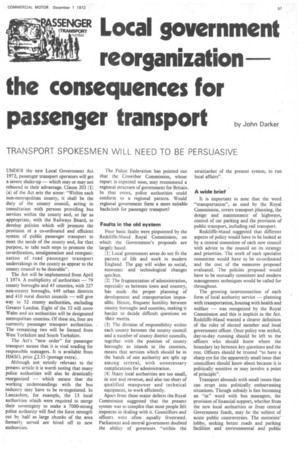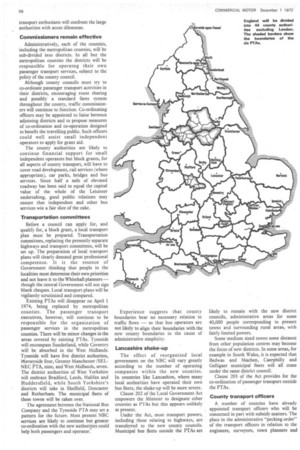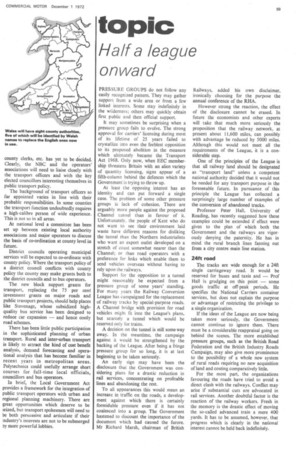sENTRAN.T?bem Local government reorganization the consequences for
Page 59

Page 60

Page 61

If you've noticed an error in this article please click here to report it so we can fix it.
passenger transport by John Darker
TRANSPORT SPOKESMEN WILL NEED TO BE PERSUASIVE
UNDER the new Local Government Act 1972, passenger transport operators will get a severe shake-up — which may or may not rebound to their advantage. Clause 203 (1) (a) of the Act sets the scene: "Within each non-metropolitan county, it shall be the duty of the county council, acting in consultation with persons providing bus services within the county and, so far as appropriate, with the Railways Board, to develop policies which will promote the provision of a co-ordinated and efficient system of public passenger transport to meet the needs of the county and, for that purpose, to take such steps to promote the co-ordination, amalgamation and reorgani: zation of road passenger transport undertakings in the county as appear to the county council to be desirable".
The Act will be implemented from April 11974. A multiplicity of authorities — 79 county boroughs and 45 counties, with 227 non-county boroughs, 449 urban districts and 410 rural district councils — will give way to 52 county authorities, excluding Greater London. Eight of the 52 will cover Wales and six authorities will be designated metropolitan counties. Of these six, four are currently passenger transport authorities. The remaining two will be formed from West Yorkshire and South Yorkshire.
The Act's "new order" for passenger transport means that it is vital reading for responsible managers. It is available from HMSO, price £2.55 (postage extra).
Although not strictly relevant to the present article it is worth noting that many police authorities will also be drastically reorganized — which means that the working understandings with the bus industry may have to be re-negotiated. In Lancashire, for example, the 13 local authorities which were required to merge their sovereignty to make a 7000-strong police authority will find the force strength cut by half as large chunks of the area formerly served are hived off to new authorities. The Police Federation has pointed out that the Crowther Commission, whose report is expected soon, may recommend a regional structure of government for Britain. In that event, police authorities could conform to a regional pattern. Would regional government form a more suitable backcloth for passenger transport?
Faults in the old system
Four basic faults were pinpointed by the Redcliffe-Maud Royal Commission, on which the Government's proposals are largely based.
(1) Local government areas do not fit the pattern of life and work in modern England. The gap will widen as social, economic and technological changes quicken.
(2) The fragmentation of administration, especially as between town and country, has made the proper planning of development and transportation impossible. Hence, frequent hostility between county boroughs and counties, making it harder to decide difficult questions on their merits.
(3) The division of responsibility within each county between the county council and a number of county district councils, together with the position of county boroughs as islands in the counties, means that services which should be in the hands of one authority are split up among several, with unnecessary complications for administration.
(4) Many local authorities are too small, in size and revenue, and also too short of qualified manpower and technical equipment, to work efficiently.
Apart from these major defects the Royal Commission suggested that the present system was so complex that most people felt impotent in dealing with it. Councillors and officers were often equally frustrated. Parliament and central government doubted the ability of governors "within the straitjacket of the present system, to run local affairs".
A wide brief
It is important to note that the word "transportation", as used by the Royal Commission, covers transport planning, the design and maintenance of highways, control of car parking and the provision of public transport, including rail transport.
Redcliffe-Maud suggested that different aspects of policy would have to be looked at by a central committee of each new council with advice to the council on its strategy and priorities. The work of each specialist committee would have to be co-ordinated and the cost of the measures proposed evaluated. The policies proposed would have to be mutually consistent and modern management techniques would be called for throughout.
The growing interconnection of each form of local authority service — planning with transportation, housing with health and welfare — was recognized by the Royal Commission and this is implicit in the Act. Redcliffe-Maud wanted a clearer definition of the roles of elected member and local government officer. Once policy was settled, day-to-day running should be left to the officers who should know where the boundary lay between key questions and the rest. Officers should be trusted "to have a sharp eye for the apparently small issue that councillors should know about because it is politically sensitive or may involve a point of principle".
Transport abounds with small issues that can erupt into politically embarrassing situations. Though subsidy is fast becoming an "in" word with bus managers, the provision of financial support, whether from the new local authorities or from central Government funds, may be the subject of acute public controversies. The motorists' lobby, seeking better roads and parking facilities and environmental and public transport enthusiasts will confront the large authorities with acute dilemmas.
Commissioners remain effective Administratively, each of the counties, including the metropolitan counties, will be sub-divided into districts. In all but the metropolitan counties the districts will be responsible for operatng their own passenger transport services, subject to the policy of the county council.
Although county councils must try to co-ordinate passenger transport activities in their districts, encouraging route sharing and possibly a standard fares system throughout the county, traffic commissioners will continue to function. Co-ordinating officers may be appointed to liaise between adjoining districts and to propose measures of co-ordination and co-operation designed to benefit the travelling public. Such officers could well assist small independent operators to apply for grant aid.
The county authorities are likely to continue financial support for small independent operators but block grants, for all aspects of county transport, will have to cover road development, rail services (where appropriate), car parks, bridges and bus services. Since half a mile of elevated roadway has been said to equal the capital value of the whole of the Leicester undertaking, good public relations may ensure that independent and other bus services win a fair slice of the cake.
Transportation committees Before a council can apply for, and qualify for, a block grant, a local transport plan must be prepared. Transportation committees, replacing the presently separate highways and transport committees, will be set up. The preparation of local transport plans will clearly demand great professional competence. It is the essence of Government thinking that people in the localities must determine their own priorities and not leave it to the Whitehall planners — though the central Government will not sign blank cheques. Local transport plans will be vigilantly scrutinized and compared.
Existing PTAs will disappear on April 1 1974, being replaced by metropolitan counties. The passenger transport executives, however, will continue to be responsible for the organization of passenger services in the metropolitan counties. There will be minor changes in the areas covered by existing PTAs. Tyneside will encompass Sunderland, while Coventry will be absorbed in the West Midlands. Tyneside will have five district authorites, Merseyside four, Greater Manchester /SEI.NEC PTA, nine, and West Midlands, seven. The district authorities of West Yorkshire will embrace Bradford, Leeds, Halifax and Huddersfield, while South Yorkshire's districts will take in Sheffield, Doncaster and Rotherham. The municipal fleets of these towns will be taken over.
The agreement between the National Bus Company and the Tyneside PTA may set a pattern for the future. Most present NBC services are likely to continue but greater co-ordination with the new authorities could help both passengers and operator. Experience suggests that county boundaries bear no necessary relation to traffic flows — so that bus operators are not likely to align their boundaries with the new county boundaries in the cause of administrative simplicity.
Lancashire shake-up The effect of reorganized local government on the NBC will vary greatly according to the number of operating companies within the new counties. In countries like Lancashire, where many local authorities have operated their own bus fleets, the shake-up will be more severe.
Clause 202 of the Local Government Act empowers the Minister to designate other counties as PTAs but this appears unlikely at present.
Under the Act, most transport powers, including those relating to highways, are transferred to the new county councils. Municipal bus fleets outside the PTAs are likely to remain with the new district councils, administrative areas for some 40,000 people corresponding to present towns and surrounding rural areas, with fairly limited powers.
Some medium sized towns some distance from other population centres may become the focus of new districts. In some areas, for example in South Wales, it is expected that Bedwas and Machen, Caerphilly and Gelligaer municipal fleets will all come under the same district council.
Clause 203 of the Act provides for the co-ordination of passenger transport outside the PTAs.
County transport officers A number of counties have already appointed transport officers who will be concerned in part with subsidy matters. The place in the administrative "pecking order" of the transport officers in relation to the engineers, surveyors, town planners and county clerks, etc. has yet to be decided. Clearly, the NBC and the operators' associations will need to liaise closely with the transport officers and with the key elected councillors interesting themselves in public transport policy.
The background of transport officers so far appointed varies in line with their probable responsibilities. In some counties the transport function undoubtedly requires a high-calibre person of wide experience. This is not so in all areas.
At national level a committee has been set up between existing local authority associations and major operators to discuss the basis of co-ordination at county level in future.
District councils operating municipal services will be expected to co-ordinate with county policy. Where the transport policy of a district council conflicts with county policy the county may make grants both to the district councils and to bus operators.
The new block support grants for transport, replacing the 75 per cent investment grants on major roads and public transport projects, should help places like Stevenage, whose subsidized highquality bus service has been designed to reduce car expansion — and hence costly road schemes.
There has been little public participation in the sophisticated planning of urban transport. Rural and inter-urban transport is likely to attract the kind of cost benefit analysis, demand forecasting and operational analysis that has become familiar in recent years in metropolitan areas. Polytechnics could usefully arrange short courses for full-time local officials, councillors and bus operators.
In brief, the Local Government Act provides a framework for the integration of public transport operators with urban and regional planning machinery. There are great opportunities which deserve to be seized, but transport spokesmen will need to be both persuasive and articulate if their tndustry's interests are not to be submerged by more powerful lobbies.
































































































































